About a hundred years ago Townsend Whelen, noted soldier and hunter, coined the phrase, “Only accurate rifles are interesting.” But many really interesting rifles come with price tags much larger than most shooters can afford. That is, unless you are willing to downsize. Not in actual size, but in caliber. Some of the most accurate rifles being fired today can be found at your local smallbore silhouette match, where only inexpensive 22 Long Rifle ammunition is allowed. The game is to stand and shoot offhand at steel replica profiles of chickens, pigs, turkeys, and rams. The object of the game is to knock them over. Regulation distances are 40, 60, 77, and 100 yards (or meters), respectively. Any type of scope may be used. Smallbore silhouette rifle competition is so well established that several manufacturers offer models built to meet the standards of the sport. That would be the case with our first test rifle, the $414 CZ 452 Silhouette. Our second rifle was the $1399 Anschtz 64 MP R or Multi Purpose Rifle, sometimes advertised as an effective training rifle for high power shooters. Our third rifle was the $750 Browning T-Bolt Target Varmint, aimed at producing accuracy at the match or in the field.
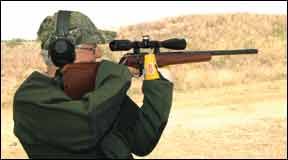
All three of our test rifles were bolt-action models with detachable magazines, a configuration that dominates the sport. Given that the ammunition played no part in cycling the action, we were free to choose a variety of ammunition. Our three test rounds consisted to two well respected target rounds from Lapua and Remingtons Golden Bullet, a popular budget-priced ammunition sold in 525-round boxes. The Remington ammunition powered a 36-grain lead brass-plated hollowpoint. Both the Lapua Midas+ and Center-X ammunition drove slickly coated 40 grain roundnosed slugs. Serious competitors are mindful to note individual lots of ammunition in order to find the best ammunition. So weve listed the lot numbers of the Lapua target rounds on our accuracy chart.
For our tests we mounted a Swarovski Z5 3.5-18X44 LBT scope with plex reticle and the Ballistic Turret option. This scope offers up to four preset zeroes. That meant in competition we wouldnt have to count clicks when changing target banks or rely on a variety of holds. With the presets easily in hand, we were free to concentrate on the center of each target instead of aiming low on the 40 yards chicks, dead center on the pigs, high on the turkeys and above the rams. Our next step was to choose the most accurate ammunition for each rifle and shoot groups from the 100-yard line. In each case our rifles were fired supported from a model 500 Rifle Rest ($280 from www.targetshooting.com), and we used the RT-073 target from www.OutdoorProducts.com. We found that each of our test rifles were so accurate that with a little effort the average shooter could be crowned top gun. In addition, we thought these rifles were good enough to be training devices for any shooting discipline, including long range prone. Were not talking about making actual long distance shots, but working in scale with smaller targets to replicate greater distance.
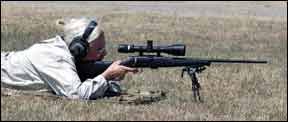
Our last test was to fire each rifle standing unsupported. With some mighty small groups achieved from the bench, we could honestly say that accurate rifles were the most fun. With access to the Rimfire Ranch at Houstons American Shooting Centers, (www.AmShootCenters.com), our enjoyment shot off the scale. With each hit the steel prairie dogs were sent back into their mounds only to rise again. The mechanical dogs placed 40 to 70 yards downrange outlasted our supply of ammunition, but we vowed to return. Lets review which rifle was the most interesting, accurate, and fun in the judgment of our testers.
Anschtz 64 MP R No. 009977 22LR, $1399
The owners manual that arrived with our model 64 MP R (multi-purpose rifle) was short on specific information. It did however sport a rather spectacular 50m target showing one ragged hole measuring about 0.45 inches across on the rear cover page, which was windowed to produce a handy reference folio. Originalschussbild lhres Gewehres 10 Schuss auf 50m (Original group of your rifle 10 shots at 50 meters), was printed directly below the Fabr.-Nr., (serial number). This particular manual was actually meant for the models 64 R and 64 RL, but the serial number matched our rifle, so we were pretty excited about our originalshussbild.
We couldnt wait to shoot some schussbilds (literal translation shot pictures) of our own. But first we learned more about our rifle. A visit to www.Anschuetz-USA.com, spelled with the addition of an “e” to make up for the lack of an umlaut (two dots over a vowel to add inflection), told us more about the Model 64 MP R. The basis for this rifle was the free floating Model 64 action. Designed for hunting or target work this model can also be purchased chambered for 17HMR. The 64 MP R utilized a heavy barrel with a target crown. There was a slight increase in the diameter of the barrel, (about 0.89 inches in outer diameter to about 0.945 inches), extending about 3.0 inches rearward from the muzzle. This area was also cut with an 11mm groove to match the receiver that could at first be mistaken for fluting. The purpose of this design was to accommodate a front sight. The increase in diameter was to provide the proper height to align with the rear unit.
The Anschtz Wave Style V-Block dovetail rail was an 11mm groove with 60-degree cut applied to the top of the receiver. This made it possible to attach scope rings directly to the receiver. There were also holes drilled and tapped for a scope base or a set of integrated base style rings. We chose to share the fine set of Talley integrated rings that arrived with our Browning T-Bolt Target rifle with the Anschtz. The bolt offered an oversized handle and a ball-shaped knob. Removing the bolt required pushing the release mounted on the left side of the action forward while simultaneously pulling back the trigger. A two-position safety (rearward for safety-on) was located directly across on the right side of the action. With the safety on, the bolt can be manipulated for clearing the chamber but cannot be removed from the action.
The heart of the 64 action was a two-stage trigger. This trigger was adjustable for weight of pull, sear contact, and length of pull. The trigger itself was nearly straight up and down with fine vertical lines on its face. The top of the trigger was crossed by a bar that was like a section of a diamond shaped rod. A simple clamp extended down from the trigger mechanism and held the trigger in place. Loosening the clamp and shifting the trigger forward or back accounted for fine adjustment in length of pull. We chose not to modify the trigger after it was delivered offering only a scary 10 ounces of resistance. We were required to use a full measure of caution each time our finger entered the trigger guard to prevent unintentional discharge. Since rimfire rifles are not meant to be dry fired (the firing pin can be damaged should it contact the edge of the chamber rather than the rim of a soft brass casing), we chose to remove the bolt of each rifle quite frequently. To protect the bolts we purchased a variety of sheaths and bolt holsters from Sinclair International, www.SinclairIntl.com). The $55 Edgewood Bolt Holster (04-7540) clipped on to our belts. The $10 Gammon Bolt Folder (04-7600) was more versatile. It could be folded and placed into a pants pocket or inside a rifle bag.
The Model 64 barreled-action was precise and sophisticated, but it was the walnut stock that helped define its multi-purpose design.
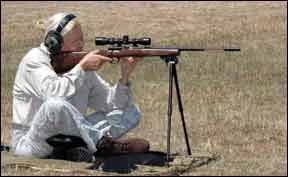
The flat bottom of the fore end was very stable for bench rest shooting. There was also an aluminum rail on the bottom side that was designed for a hand-stop or sling attachment. The rail was calibrated so positions could be recorded and repeatable to accommodate more than one shooter. Its more likely purpose would be to suit the competitor as he assumes different positions throughout the course of a match. The pistol grip area was knurled for adhesion. Its contour offered a somewhat neutral palm swell with only slight favor for the right-handed shooter. The inside diameter of the trigger guard was large and open. The comb was high and nearly straight in pitch. The cheekpiece was comfortable enough for the left-handed shooter to be considered ambidextrous.
The buttstock was fit with a rubber face pad that was adjustable for height. Loosening the beefy 5/32-inch Allen screw (non-metric, thank you very much), allowed the pad to slide up or down on the polymer base. There was much more adjustment available for raising or lowering the cheek piece than anyone will likely use. The trick was a floating lug that allowed the buttpad to ride up and down on a track that eliminated any possibility of slop in the final engagement. Length of pull could also be adjusted by removing the supplied spacer. The spacer could be removed or installed without completely removing the buttpad. There was a hole in the stock along the right side of the buttstock just short of the rear face. Downloading the online catalog showed us that this was for connecting an optional butt plate carrier that offered a tilting column guide.
Fired from a standing position, the MP R was quite muzzle heavy. Overall weight was the greatest of our three test rifles by far. This is a consideration especially for the beginning silhouette shooter. If you cant hold the rifle on target for very long, you wont practice very much, let alone enjoy participating in a match. But we found two features in place to help us out. The underside of the fore end was nice and flat and the rail did not interfere. This offered a stable platform. But the key was to get the support hand as close to the balance point of the rifle as possible. Removing the spacer from between the butt pad and the stock shortened the distance from the shoulder to the support hand, reducing the amount of energy it took to support the rifle.
The Anschtz 64 MP R was delivered with one 5-round magazine. The magazine catch was the only mechanism on the rifle we would take issue with. The motion to release was a forward push. Once the magazine was in place the release lever was supposed to retreat to its rearward position. But sometimes it would stick in the forward/release position and other times it could not be budged from its rest position. The gripping surface was grooved but still rather slick. The back edge of the lever was all but recessed below the trigger guard plate, so there wasnt much leverage available. We tried working the lever without the magazine in place but the action still proved balky. The release-lever spring was quite heavy, but it seemed like the lever itself was burred, oversized, or out of alignment. Were sure this would be an easy fix under warranty, but in the mean time we found it annoying.
In comparing performance from a sandbag rest, we learned that the Anschtz 64 MP R benefited most from our selection of premium ammunition. At the bottom of our accuracy chart, we saw that the Anschtz actually finished in third place firing the bulk-packed Remington budget ammunition. But the Anschtz was the most
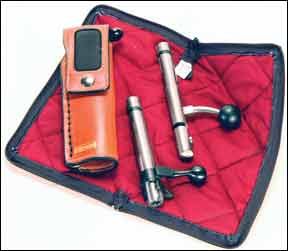
accurate rifle when firing the Lapua match ammunitions. The 64 MP R was the only rifle to produce a 50-yard average group size measuring less than 0.40 inches across, firing the Midas-X ammunition. None of our other rifles came close once we loaded the Anschtz with the Lapua Center-X rounds. Average group size was just 0.27 inches from the 50-yard bench. Doing the math, we expected a 0.54 inch average size group from the 100-yard line. Our talented rifle tester was able to better this mark, producing groups that ranged in size from 0.38 inches to 0.60 inches across for a computed average size group of 0.49 inches.
Our Team Said: Anschtz rifles are not stocked in every gun shop but can be ordered through Steyr Arms in Trussville, Alabama. The MSRP of the 64 MP R might scare away some buyers, but weve found them for less money through well respected dealers such as www.ChampChoice.com and www.ChampionShooters.com. There are several Anschtz rifles available with features more specific to competitive shooting, but we liked the 64 MP R because it had a measure of flexibility. Actually, there arent that many rifles, rimfire or centerfire, that are as sophisticated or capable as the 64 MP R at any price, let alone just north of $1000. Not many enthusiasts will be able to outshoot this rifle as is, let alone get tired of it any time soon. This is a very interesting rifle.
CZ 452 Silhouette No. 02030 22 LR, $414
If the Anschtz 64 MP R is one of the more complex and intimidating rifles you can buy, the CZ 452 Silhouette has to be among the friendliest. The magazine release problem we had with the Anschtz was solved by a simple vertical lever on the CZ. Whereas you might have to bulk up just to hoist the Anschtz into position, the CZ 452 Silhouette was built on a black synthetic stock with a moderate gauge 22-inch free-floated barrel that left the rifle light enough to enjoy over a longer string of fire than its supplied 5-round magazine can sustain. (Optional 10-round magazines were also available). Those desiring a true heavy barrel might prefer the CZ 452 Varmint, but then you wouldnt benefit from the ergonomics of the Silhouette. We really liked the thick rubber butt pad and the cheek contour on the left side of the stock. While not an uncomfortable rifle for the left-handed shooter, the bold contour added to the left side afforded the right-handed shooter one of the best cheek welds weve found. The CZ did not have a trick butt pad or other means of raising the stock, but the cheek piece was so useful no one on our staff had any trouble obtaining proper alignment or a comfortable, solid mount. Southpaws might prefer the model 452 American 02017, which is now offered exclusively for left-handed shooters. This rifle, however, was built on a Turkish walnut stock and lacks the raised comb of the Silhouette model, which the manufacturer refers to as being “a slight Monte Carlo.” The stock offered sling studs front and rear, and the fore end showed a thinning profile capped with a Schnabel fore end. Devoid of checkering, the thin pistol grip still found favor from our team, particularly the way it indexed to the wide valence trigger.
The action was machined with an 11mm groove for direct attachment of rings. This groove will also accommodate the application of the $45 aluminum Weaver Adaptor Rail that we used in this test, (part number 19008 from www.CZ-USA.com, made in U.S.A.). The barrel and oversize bolt knob were blued, but the bolt was bright stainless steel. A two-position safety was integrated with the bolt (forward for safety-on). Once on safe, the bolt was locked into position. The trigger was adjustable for take-up, overtravel and weight of pull. Access to the adjustment was with the stock removed, which was simple enough but we were satisfied with the crisp 3.0 pound trigger as it arrived from the dealer. The 452 series rifles, also available chambered for 22 WMR, 17HMR, and 17HMR2, are not equipped with a set trigger. Those desiring a set trigger should try the CZ 453 series rifles.
From the 50-yard bench the CZ 452 Silhouette came as close to tying the Browning T-Bolt for second place as we can compute. But we should note that the CZ was more accurate according to its 100-yard target. With the Lapua Center-X, the average size groups from the 50-yard line were dead even, but the longer-range target showed about a 0.09 inch differential in favor of the 452 Silhouette. Actually, the gap should have been wider because we managed to “flub” a shot that forced us to factor in a 1.05-inch group along with four other groups that varied as little as 0.54 inches to 0.57 inches across. All along, our testers were raving about the CZ as second only to the Anschtz, and we think this back story proves they were right.
Our Team Said: Anyone getting their feet wet in Steel Silhouette competition wont be sorry they started with the CZ. Fit with a synthetic stock, it should make a great all-weather handy rifle. It is remarkable that in order to gain a significant improvement in performance over a $400 rifle, one must spend more than twice as much. We bet anyone who moves on to a more expensive rifle will not trade in or sell their CZ 452 Silhouette.
Browning T-Bolt Target/Varmint 22LR
025176203 22 LR, $750
Priced about midway between the Anschtz and CZ USA rifles, the Browning T-Bolt Target/Varmint was yet another expression in bolt-action design. The T-Bolt design does not rotate the bolt nor does it require the operator to lock and unlock the action with an up-and-down motion. This was similar to the Blaser line of rifles, and designs used in Biathlon competition. Cycling a fresh round into the chamber was accomplished with a short stroke to the rear, then forward to seat the round and fix the bolt. Working the bolts of the other rifles, we felt the cycling process was at least half our doing. The T-Bolt could be operated so quickly with relatively little movement, it was almost as if we were aiding a semi-automatic that needed just a little bit of help.
The T-Bolt fed from a rotary magazine that seated nearly flush with the bottom of the receiver. The other rifles seated their magazines nearly flush but in order to maintain a flat profile the single column magazines were necessarily limited to 5-rounds. The Browning Double Helix magazine held ten rounds in an “S”-shaped pattern riding inside the paddles of two spools rotating one above the other. We found this magazine to be easy to load, unload, insert and remove from the magazine well. Operation was completely reliable.
The one-piece satin -finish walnut stock was very pleasing to hold and to look at. The pistol grip and fore end were checkered, and the comb was raised in a Monte Carlo profile. Sling studs were seated front and rear. The butt pad was hard plastic but offered a classic appearance. Weighing almost 7 pounds with scope, including a 22-inch-long heavy barrel, the hard buttpad did not cause us to suffer felt recoil. Our other test rifles were each fit with rubber buttpads that may have been more useful for providing grip upon the shooter than diffusing shock.
The two-position safety was mounted on the tang directly behind the bolt where it was within easy reach of the shooters right or left thumb. We could, however, perceive the slightest favor to the right-handed shooter by way of a slight cast off and just a hint of increased palm swell along the right side of the pistol grip. Also mounted on the tang was the bolt release. To remove the bolt the safety must be in the rearward “on” position. Unlocking the bolt with as little rearward movement as possible, the release, which at this point was almost hidden beneath the rear of the bolt, can be pressed, freeing the bolt from the action. The receiver was drilled and tapped for a scope mount or rings. We used a set of $45 standard height CNC-machined Talley integrated scope mount rings that bolted directly to the receiver, (No. 12338 from www.Browning.com).
Browning rifles and several of the companys shotguns offer a trademark appearance of a walnut stock, blue action and gold trigger. The T-Bolt was no exception, and the index from the grip to the trigger face was, in our opinion, the most comfortable of our three rifles. The T-Bolt trigger was adjustable for pull weight without disassembly. Located immediately forward of the trigger guard was a relief that offered access to a 1/16-inch Allen screw. Turning the screw clockwise increased trigger pull, but we fired our tests with the factory setting of 4.0 pounds. Take-up and overtravel were preset and not adjustable. That was fine with us, because as delivered, the trigger was light and remarkably crisp. The overall feel of breaking the trigger was something akin to an electronic switch.
From the 50-yard line the Browning shot group sizes that were slightly smaller on average than the CZ rifle but were splitting hairs. Both the CZ and Browning were more accurate with the Remington Golden Bullet ammunition, but lagged behind the Anschtz once the higher-grade Lapua rounds were applied. But shots from the 100-yard line with the Lapua Center-X ammunition told us that the Browning was capable of consistently shooting about MOA on average.
Shot from the standing position, the Browning T-Bolt Target/Varmint felt smaller than it actually was. Well balanced, we had to remind ourselves that we were firing through a 22-inch heavy barrel. We think this sensation was due at least in part to the compact mechanism of the straight-pull action. The stroke was very short and favored a crisp aggressive stroke to work the action. It was stiff at first, but with a light oiling, the amount of effort necessary to cycle the T-Bolt became easier and the action broke in.
Our Team Said: The Browning T-Bolt Target/Varmint is a handsome, distinctive-looking rifle that offers a slightly different shooting experience than other 22s. Its high-capacity magazine can be switched out quickly. The action was quick enough so that rapid-fire operation can be enjoyed at a much faster rate than other bolt-action designs with less interruption in mount or sight picture. Combined with the short, crisp trigger, we liked the overall feeling of efficiency that made this rifle fun to shoot.
0711-SMALLBORE-ACC-CHRONO-DATA.pdf
0711-BROWNING-T-BOLT-TARGET.pdf


























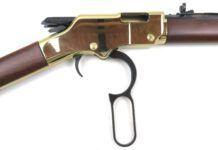

They are all good ,all depends on who is doing the shooting . Some days we are better than other days to shoot. I am a
Browning person.